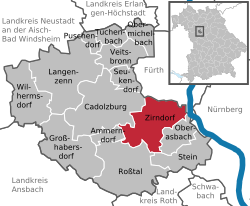Zirndorf
| Zirndorf | ||
|---|---|---|
|
||
| Coordinates: 49°27′N 10°57′E / 49.450°N 10.950°ECoordinates: 49°27′N 10°57′E / 49.450°N 10.950°E | ||
| Country | Germany | |
| State | Bavaria | |
| Admin. region | Mittelfranken | |
| District | Fürth | |
| Government | ||
| • Mayor | Thomas Zwingel (SPD) | |
| Area | ||
| • Total | 28.78 km2 (11.11 sq mi) | |
| Elevation | 306 m (1,004 ft) | |
| Population (2015-12-31) | ||
| • Total | 24,627 | |
| • Density | 860/km2 (2,200/sq mi) | |
| Time zone | CET/CEST (UTC+1/+2) | |
| Postal codes | 90513 | |
| Dialling codes | 0911, 09127 (Wintersdorf, Weinzierlein) | |
| Vehicle registration | FÜ | |
| Website | www.zirndorf.de | |
Zirndorf is a town, which is part of the district of Fürth. It is located in northern Bavaria, Germany in the Regierungsbezirk of Middle Franconia.
The following towns and municipalities share borders with Zirndorf; they are listed in clockwise order, starting in the north:
The first mention of the town occurs in a document dated 9 September 1297. The town was virtually destroyed during the Thirty Years' War, though the brewing industry established in the late seventeenth century helped in its recovery. In the mid-nineteenth century, the toy industry contributed to the town’s industrial development, and remains important today.
In 1935 the city of Zirndorf applied to the German Reich Administration to have a caserne built here. The application was approved, with the condition of Reichsmarschall Hermann Göring, that construction must be in the Franconian style. The plans were prepared by the Construction Office of the German Air Force, and work began on the Barracks in the spring of 1938. It was completed in mid-1940. This Spotlight and Anti-Aircraft Barracks as it was then called, was one of the best military training barracks in the Third Reich.
In 1945, soldiers of the U.S. 26th Infantry Regiment occupied the barracks. On 11 May 1949, this barracks was renamed in honor of John J. Pinder Jr., an American soldier who fell in a battle near Colleville-sur-Mer, France, on 6 June 1944. For his bravery, he was posthumously awarded the Medal of Honor.
In the decades since 1945, many American units were stationed at Pinder Barracks. The 1st Armored Division's Divisional Artillery (DIVARTY) called Zirndorf home from 1971 until shortly after the Gulf War in 1991. Shortly thereafter, the Army and Air Force Exchange Service, Europe (AAFES-Europe), headquartered their operations at Pinder Barracks. In the fall of 1993, the 7th Corps Support Group moved its home to Pinder Barracks as well. Within the departure of AAFES-Europe and the 7th Corps Support Group, the chapter of America's presence in Zirndorf came to a close.
...
Wikipedia



